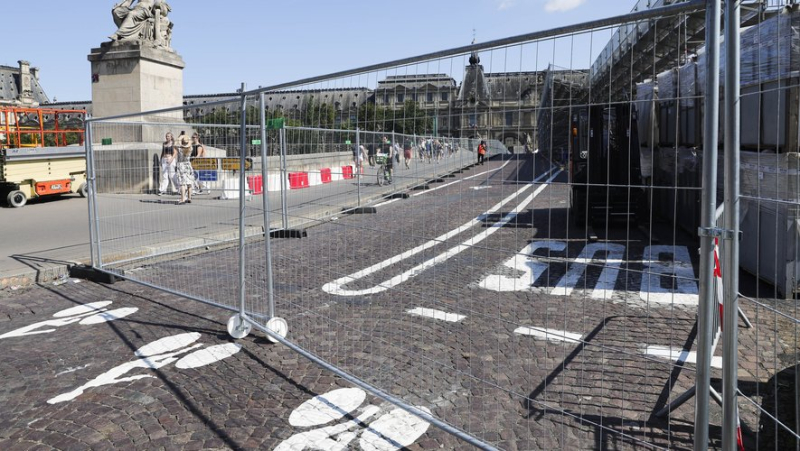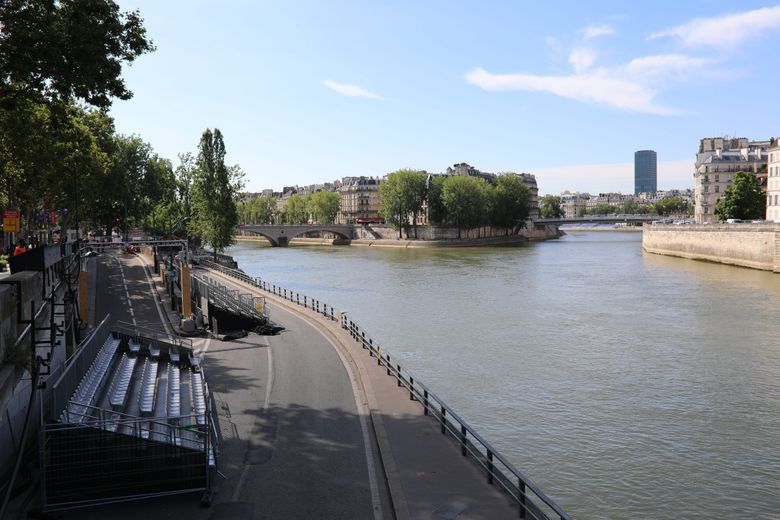Paris 2024 Olympic Games: the protective perimeter for the opening ceremony deployed on Thursday

Les préparatifs de la cérémonie d’ouverture des JO de Paris 2024 vont bon train. EPA – TERESA SUAREZ
From Thursday until July 26, the internal security and counter-terrorism perimeter (SILT) will be activated in Paris near the banks of the Seine, in preparation for the opening ceremony of the Olympic Games.
326 000 spectators – 104,000 paid places on the low platforms, 222,000 free places on the high platforms – are expected on July 26 to attend the opening ceremony on the Seine, the first in the history of the Games which will take place outside a sports venue.
Here is how the protection perimeter works, supposed to ensure the safety of spectators, athletes and local residents on the day of the ceremony, and the dismantling phase of which will begin on July 27.
Who is allowed to enter ?
Only local residents, professionals and visitors (with proof of reservation for a hotel, museum or restaurant for example) will be able to access this perimeter, upon presentation of a "game pass".
Athletes and ticketed spectators, as well as persons accredited by the Organizing Committee of the Olympic Games (July 26 – 11 August) and the Paralympic Games (August 28 & September 8) will also be able to penetrate the protection perimeter.
All will nevertheless be subject to a search and palpation procedure.

The Seine will be the scene of the opening ceremony. MAXPPP – Mickael Chavet
From July 18 to 26 inclusive, "gray and red" will surround the competition sites. Access to the gray perimeter, known as "SILT", will be prohibited to motorized vehicles except for rare exceptions, particularly for emergency vehicles.
In the red perimeter, motorized traffic will be permitted for duly authorized people with proof. Pedestrians and cyclists will be able to move freely there.
Which areas are affected ?
Almost all the banks of the Seine in Paris intra muros are affected by the protection perimeter, from the Tolbiac bridge (12th-13th arrondissements) to the Garigliano bridge, connecting the 15th and 16th arrondissements.< /p>
From the Austerlitz bridge to the Debilly footbridge, all passages from one bank to the other of the river are included in the "SILT" perimeter.
The area expands from Place du Trocadéro to the Champ de Mars, where protocol ceremonies are planned for July 26.
Espace urbain, JO et surveillance
JO 2024 : la carte du périmètre où il faudra un QR code pour entrer une semaine avant la cérémonie d’ouverturehttps://t.co/HBX48bSl8y pic.twitter.com/T0EFzCsNwl— Sylvain Genevois (@mirbole01) April 9, 2024
The Saint-Louis and de la Cité islands as well as the Tuileries gardens are also part of the anti-terrorist security perimeter.
Consequently, the metro stations Concorde, Tuileries, Cité, Quai de la Rapée, Trocadéro, Passy, Châtelet, Alma-Marceau, Pont Neuf and Pont Marie will be closed from Thursday until&rsquo ;to July 26.
The Champs-Elysées-Clemenceau station will close from July 20 until the day of the opening ceremony.
On July 26, almost all of line 6 as well as all metro stations located near the quays of the Seine will be inaccessible, and bus stops in this area will not be accessible. will not be served.
Activation duration
The perimeters called "SILT" are set up by the police headquarters from July 18 to 26, to allow preparation for the opening ceremony of the Olympic Games, which will see 10,500 athletes from 206 delegations parade on the Seine.
Also read: Paris 2024 Olympic Games: "All they have to do is throw peanuts at us", "The feeling of being locked in" … Parisians annoyed by the preparations
The route, 6 kilometers long, will begin at the Austerlitz bridge and end at the Iéna bridge.




